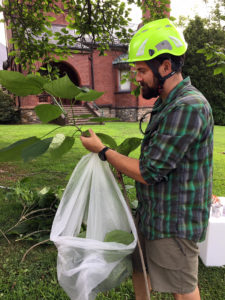By Cathy Moritz

Sean Halloran, head of woody plant propagation for Arnold Arboretum, takes a cutting of Lincoln’s catalpa tree.
Sean Halloran, head of woody plant propagation at the Arnold Arboretum of Harvard University, has generously agreed to attempt to reproduce a twisting offspring of the town’s beloved Northern Catalpa tree in front of the Lincoln Public Library. Halloran’s work is at the joint request of the Lincoln Garden Club and the Friends of the Lincoln Library.
The catalpa has graced the grounds of the Lincoln Library and sparked conversations in Lincoln since the early 20th century, but it’s well beyond the typical catalpa lifespan of 60 years and won’t live forever. The hope is to grow a genetically identical twisting “daughter tree” to plant nearby on the library grounds so future generations can enjoy the same beautiful tree we have.
Arboretum staff are using several reproduction techniques. On July 22, Halloran and an intern took many cuttings of new growth up in the upper branches, and 115 of them are now planted in an Arboretum greenhouse under the best conditions. This fall, they will gather seeds from the tree before they fall to the ground where they can pick up disease.
Halloran has not located another catalpa in the immediate area. He believes that the tree is self-pollinating, so that its seeds are probably genetically identical to the parent tree. Next winter, one or more small limbs will be taken and grafted onto catalpa stumps, employing the same technique used to grow apple cultivars. Root cuttings, which can be dangerous to the tree, are under consideration but will not be used without further discussion and permission from the library trustees.
This project will take several years, and it may not be immediately apparent that any of the tree’s offspring will have the twisting characteristic. Halloran explained that tree genetics are even more complicated than human genetics and their expression is affected by the environment just as human genes are, so that there is no guarantee that any offspring will twist. But he assures us that the Arboretum staff will take whatever time is needed to complete the project. They are using it as a learning experience for their interns. Meanwhile, they’re also advising us on how to preserve the existing tree.
Coordinating the effort is the Lincoln Garden Club, with assistance from the Friends of the Lincoln Library; Barbara Myles, the library’s director; and the library trustees. Myles reported that town residents are very concerned about the tree and contact her frequently in the spring, when the month of May often goes by with nary a leaf appearing. In early June, the catalpa’s bare branches leaf out very rapidly. Halloran noted with interest that for unknown reasons, Lincoln’s catalpa blooms three to four weeks after the catalpas at the arboretum and is, quite literally, a “late bloomer.”
What a wonderful, collaborate effort by all involved.
Why did it take 50 years to do this?